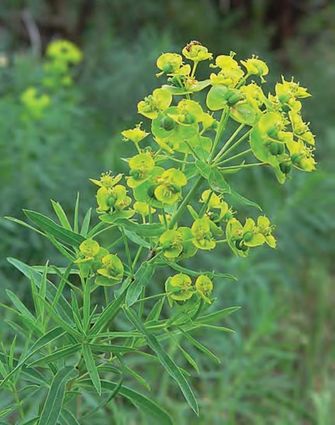News From the Musselshell Watershed Musselshell Watershed Coalition June 2020
July 15, 2020
Weed Spotlight: Leafy Spurge (Euphorbia esula)
By Andrew Sanders, Big Sky Watershed Corps, Musselshell Watershed Coalition
What is it?
Leafy spurge is a highly invasive and noxious weed that was introduced to the United States from Eurasia. It grows to be about 1-3ft tall, has a milky, latex sap, and small yellow-green flowers. The latex sap is poisonous to cattle and horses, causing blistering and skin irritation if they come in contact, and scouring and death if consumed. Cattle and horses will refuse to graze it, but can eat it accidentally if they are given infested hay. Leafy spurge is one of four noxious plants reported in every Montana county every year.
What makes it so invasive?
Leafy spurge is a perennial weed with deep and extensive root systems that can send up multiple clumps of shoots, meaning it can quickly outgrow other species of plants. On top of that, leafy spurge puts toxins into the soil that poison neighboring plants. Its seed pods can launch seeds as far as 20ft when they pop open, and its seeds can remain viable in the soil for up to 10 years. Leafy spurge seeds also remain viable in the guts of grazing wildlife and birds, which can transport them many miles before defecating. The seeds are also transported by flowing water and vehicles.
What can be done to prevent a Leafy Spurge infestation?
The best defense against leafy spurge is to keep an eye on your property, so you can detect and treat new patches before they take hold. If you do find a patch, avoid driving through it or mowing it in late summer when it has visible seeds, and carefully clean any equipment that you used after treating it. If you move livestock out of an infested area, quarantine them for 4-5 days so that any seeds can have time to pass out of their gut.
What can be done to treat a Leafy Spurge infestation?
Chemical treatment
Roadsides and other non-grazed areas: 6-8oz/ac Method with a non-ionic surfactant.
Pastures and rangeland: 2qt/ac Grazon P+D in spring or fall before a frost; 16oz/ac Tordon 22k & 4oz/ac Overdrive in spring or fall before a frost; 32oz/ac Tordon 22k before a frost; 48oz/ac 2,4-D in spring and fall.
Physical treatment
Pulling is practical for only the smallest patches due to deep and extensive roots. Tilling is moderately effective, but must be done consistently every 3 weeks throughout the growing season, at a depth of at least 4". Tilling can also spread leafy spurge, as tiny root fragments can quickly form new plants. Mowing can be effective if the plant is consistently mowed in the early flowering stage.
Biological treatment
Leafy Spurge Flea Beetles have been shown to reduce the size of leafy spurge stands by over 90% in the northern plains. The Leafy Spurge stem borer, leafy spurge tip gall midge, and leaf tier moth are also helpful enemies of leafy spurge. Multi-species grazing is another effective biological control: goats and sheep can and will eat leafy spurge.







Reader Comments(0)